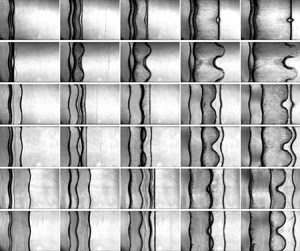Article contents
On shock-induced heavy-fluid-layer evolution
Published online by Cambridge University Press: 08 June 2021
Abstract

Investigation on the shock-induced finite-thickness fluid-layer evolution is very desirable but remains a challenge because it not only involves both the Richtmyer–Meshkov instability (RMI) and the Rayleigh–Taylor instability (RTI), but also strongly depends on the waves reverberated inside the layer. We experimentally and theoretically examined the evolution of a shocked  $\textrm {SF}_6$ gas layer with a finite thickness surrounded by air. Specifically, three kinds of quasi-one-dimensional
$\textrm {SF}_6$ gas layer with a finite thickness surrounded by air. Specifically, three kinds of quasi-one-dimensional  $\textrm {SF}_6$ gas layers with different layer thicknesses are generated to study the wave patterns and interface motions, and six types of quasi-two-dimensional
$\textrm {SF}_6$ gas layers with different layer thicknesses are generated to study the wave patterns and interface motions, and six types of quasi-two-dimensional  $\textrm {SF}_6$ gas layers with diverse layer thicknesses and amplitude combinations are created to explore the interfacial instabilities of the layer. When the initial fluid layer is thin, the two interfaces of the layer coalesce at a late time. The present study is the first to report that except for the RMI induced by a shock wave on the two interfaces, the rarefaction waves (RW) inside the fluid layer induce the additional RTI and decompression effect on the first interface, and the compression waves (CW) inside the fluid layer cause the additional Rayleigh–Taylor stabilisation (RTS) and compression effect on the second interface. A general one-dimensional theory is established to describe the motions of the two interfaces. Linear and nonlinear models are successfully established by considering the interface-coupling effect on the RMI and the additional interfacial instabilities induced by these waves inside the heavy fluid layer. The established models predict well the perturbation growths on the two interfaces at all regimes.
$\textrm {SF}_6$ gas layers with diverse layer thicknesses and amplitude combinations are created to explore the interfacial instabilities of the layer. When the initial fluid layer is thin, the two interfaces of the layer coalesce at a late time. The present study is the first to report that except for the RMI induced by a shock wave on the two interfaces, the rarefaction waves (RW) inside the fluid layer induce the additional RTI and decompression effect on the first interface, and the compression waves (CW) inside the fluid layer cause the additional Rayleigh–Taylor stabilisation (RTS) and compression effect on the second interface. A general one-dimensional theory is established to describe the motions of the two interfaces. Linear and nonlinear models are successfully established by considering the interface-coupling effect on the RMI and the additional interfacial instabilities induced by these waves inside the heavy fluid layer. The established models predict well the perturbation growths on the two interfaces at all regimes.
JFM classification
- Type
- JFM Papers
- Information
- Copyright
- © The Author(s), 2021. Published by Cambridge University Press
References
REFERENCES
- 29
- Cited by



